Abstract: According to a report by Monsanto, Paraguay is the most transgenic country considering the surface cultivated with GMOs. This supposes a remarkable development of the productive forces that deeply alter the relations of production with the emergence of new actors and the disappearance of others; the development of new technologies also has consequences on human health, in the intense environmental pollution, and in deforestation of fragile ecosystems. So far this century, large biotechnological corporations that promote the globalized agri-food regime employ technologies suitable for transgenic crops being the most emblematic the RR of the Monsanto that requires economy of scale associated with land concentration and its hoarding and uses pesticides in increasing amounts, a characteristic that makes it self-destructive as a new form of accumulation. While the dominant actors become the representatives of large corporations, soya-based Brazilian agribusiness entrepreneurs depend on those who control technology and markets. The agrarian restructuring also involves the installation and operation of large Brazilian corporations that control the meat industry.
Keywords:Biotechnology, Neoextractivism, Environmental impact,Sustainability, Paraguay.
Resumen: Según un informe de Monsanto, Paraguay es el país más transgénico considerando la superficie cultivada con OGM. Esto supone un desarrollo notable de las fuerzas productivas que alteran profundamente las relaciones de producción con la aparición de nuevos actores y la desaparición de otros. El desarrollo de nuevas tecnologías también tiene consecuencias en la salud humana, en la intensa contaminación ambiental y en la deforestación de ecosistemas frágiles. En lo que va de este siglo, las grandes corporaciones biotecnológicas que promueven el régimen agroalimentario globalizado emplean tecnologías adecuadas para los cultivos transgénicos, siendo el RR más emblemático del Monsanto que requiere una economía de escala asociada con la concentración de la tierra y su acumulación y utiliza pesticidas en cantidades crecientes, una característica que lo hace autodestructivo como una nueva forma de acumulación. Mientras que los actores dominantes se convierten en representantes de grandes corporaciones, los empresarios brasileños de agronegocios, basados en la soja, dependen de quienes controlan la tecnología y los mercados. La reestructuración agraria también implica la instalación y operación de grandes corporaciones brasileñas que controlan la industria de la carne.
Palabras clave: Biotecnología, Neoextractivismo, Impacto ambiental, Sostenibilidad, Paraguay.
Artículos
THE EXPANSION OF AGRIBUSINESS AND THE AGRARIAN RESTRUCTURING
LA EXPANSIÓN DE LA AGRICULTURA Y LA REESTRUCTURACIÓN AGRARIA
Universidad Nacional de Quilmes
Received: 06 May 2019
Accepted: 30 October 2019
In recent years, in the period between 2012 and 2016, the Paraguayan economy grew by 6.5% per year; the contribution of agriculture to GDP is close to a quarter, while the exports GDP ratio reaches 36% in 2014; according to the composition of exports, 68% of them are primary products (agriculture and livestock), a fact that makes the national economy vulnerable to external economic conditions, particularly to the instability of the commodity prices.
The exploitation of natural resources that has intensified in recent years reinforces the proposal for economic growth based on exports; even when the increase in foreign currency associated with greater harvests has the peculiarities of that of any enclave economy; the increase in exports implies more foreign currency, which according to proponents of the theory of the spill ends up reaching all; critics to the aforementioned theory assume rather that this growth entails an increase in socio-economic asymmetries (Rodríguez, 2017).
The economy in question is based on natural resources exploited with a short-term vision that only seeks to maximize income from the business sector at the expense of sustainability; the reproduction of the production process without undermining their natural resource base is one of the great challenges of Paraguayan society, and it is closely associated with the expansion of the agribusiness that drives the extractivism of new stamp. This fact gives relevance to the question about the depth of agrarian restructuring caused by the expansion of agribusiness and its socio-environmental impact. The basic hypothesis points to new forms of social Darwinism and socio-environmental deterioration caused by the expansion of GMOs agribusiness; it is assure as well about the socio environmental high passive of Neoextractivism the self-destructive characteristic of the employed technology.
The neo extractivism responds to the globalized agrifood regime based on the genetic intervention practiced by the large corporations that become the dominant economic actor; the exploitation of nature with extractivist practices oriented to the export of commodities occur within the framework of the logic of the globalized markets that impose their conditions (Cáceres, 2015). In Paraguay, the expansion of soybean agribusiness is more intense than in other countries, its effects are more marked, and it has the open support of the State (Palau et al, 2016).
The new dominant economic actor controls through the seed of GMO crops the entire process of food production including its distribution (Otero, 2012). This article analyzes the resulting agrarian restructuring and the changes in relations of production, emphasizing the development of productive forces and some of their socio-environmental consequences.
A contribution consists in the discussion of some of the effects of the GMO technologies exploiting secondary data of statistical type and results of recent research; given the controversial nature of the proposed proposals, an extensive bibliography is presented providing the pertinent evidence.
The article analyzes policies resulting from an alliance between the State and the agribusiness entrepreneurs that generates the political conditions for the increasingly intense use of pesticides and deforestation. These are interventions by social actors with social and environmental impacts, which raises the need for a transdisciplinary approach that integrates natural sciences with social sciences. The article uses coincident results of research in biomedical sciences on the incidence of health problems due to exposure to pesticides; information from the Ministry of Public Health and Social Welfare (2017) on mortality is also used. Statistical series on production (CAPECO, 2018), deforestation (WWF, 2016;Yanosky, 2013) and importation of pesticides (SENAVE, 2018a, 2018b), are also analyzed. The analysis of the relation between variables uses the comparison between percentage growing rates which are enough for the article purposes.
Agribusiness turned out to be one of the solutions to the crisis of overaccumulation of global capitalism; in the face of falling profits, the owners of capital need means to absorb the surplus and the exit by hand was the spatial expansion (Harvey, 2004)[1]. In turn, Phillip McMichael (2015) looks at the food regime in the 21st century from the agri-food trade; in this perspective the production and consumption of food on a global scale is associated with historical phases of the exercise of power relations. The corporate food regime starts from the neoliberal globalization project, with a predominance of the world market, with the open support of governments and multilateral organizations to free trade and large corporations. [1]
The author highlights the fact that the general crisis of accumulation in the early 21st century caused the migration of financial capital to investments in companies that monopolize land for agribusiness. In that logic, the agro-business of soybean is a good alternative, although it begins to decline in production and productivity, which manifests the self-destructive nature of the productive forces in their more developed links.
In the Paraguayan case, transgenic soybean is the emblematic crop, and in its production, genetic engineering techniques are used recombining the DNA of seeds. Unlike the classical extractivism, which was based exclusively on large transnational corporations, the currently practiced in the production phase relies on companies owned by natural persons while large corporations control technology, the supply of inputs, processing and marketing.
This expansion of soybean production is such that between the 2002/2003 and the 2015/2016 crop year, the cultivated area is multiplied by 2.2, reaching 3,264,480 hectares totaling 9,216,937 tons in the last season, as illustrated in Figure 1. This intense soy production responds both to the crisis of over-accumulation of capital and to the increasing demand of the international market. In order to measure the importance of the data referred to, it must be taken into account that the production of GMOs is not limited to soybeans, and with other GM crops cover 3.6 million hectares; although it is true that in the world ranking Paraguay is the sixth country considering the cultivated area, after the United States, Brazil, Argentina, Canada and India, considering the proportion of the total area occupied by transgenic, our country is the largest adopter of transgenic crops and to that extent the most exposed to the effects of production technology in use (ISAAA, 2017)[2].
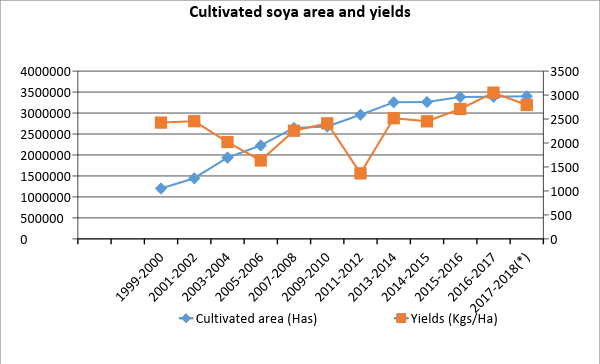
Figure 1
Cultivated soya area and yields
CAPECO (2018).
Also large rice companies are part of the agro business and they are in full expansion; a case that illustrates the conditions of its insertion in the agrarian structure and gained notoriety in the first months of 2017 is that of the rice Villa Oliva (Ñeembucú) recently implanted exploiting 6,000 hectares and plans to double the area under cultivation; in the first phase of its productive process eliminates the biomass burning it, and then herbicide spraying, in addition to altering the dynamics of wetlands.
Several factors explain the modalities of agribusiness expansion in the Paraguayan case, and considering institutional aspects highlight the high levelsof corruption and the weight of large corporation agents and of small business elite in control of the State; to the quality of natural resources external factors add up. In this sense, considering the favorable the international market conditions, should take into account the substantial increase in demand for soybean seed and soybean oil as well as other commodities, as reflected in Figure 2, which demonstrates the increasing prices paid between 2002 and 2015, which is multiplied by three in the soybean oil case.
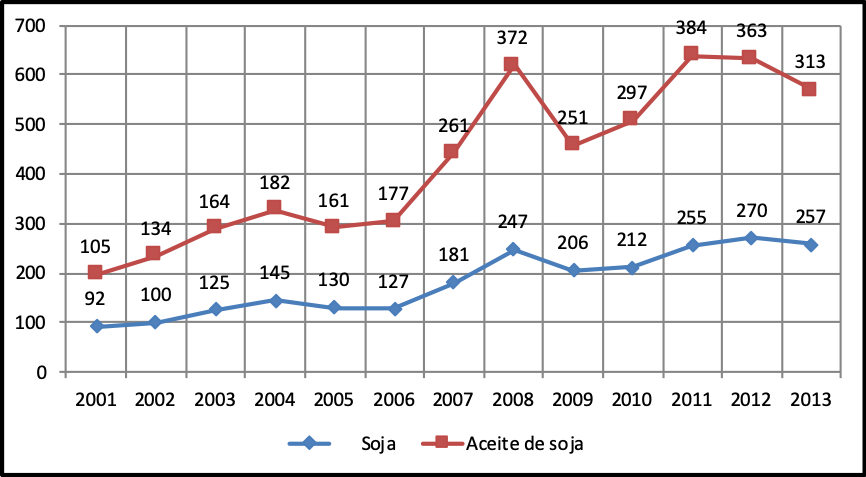
Figure 2
Soybean and soybean oil price indexes in the International Market, 2001-2014.(Index 2000 = 100)
United Nations. Statistical Annex (2014).
The notable increase in demand for commodities, linked to the troubled and uncertain neoliberal globalization, which promoted the expansion of soybean agro business, it is altered from 2015, and not looms short term recovery of previous levels. Certainly the path of these markets becomes uncertain.
The technology of transgenic is that of genetic engineering, which transfers genes from one organism to another, even if they belong to different biological kingdoms, so that the receptor organisms of these genes express properties of those genes. In order to achieve glyphosate-resistant soybeans (and then to other crops such as corn), the resistance genes of soil bacteria were incorporated into the DNA sequence of the new varieties; hence, the resulting plants are not harmed when sprayed with the herbicide.
Glyphosate, the basic component of RR technology developed by Monsanto the giant in biotechnology is a systemic herbicide, non-selective, broad spectrum, used worldwide for the removal of broadleaf weeds and woody species; its application grew as they were creating resistant transgenic events up to become the biggest selling pesticide. The undesirable effect of this RR technology ingredient is the proliferation of resistant weeds and the need to apply more amounts of pesticides per hectare thus havinga fall in profitability and greater pollution.
Annual growth (in %) of soybean area and pesticides import
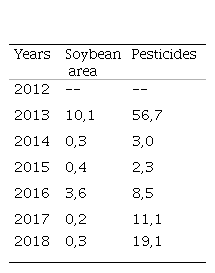
SENAVE (2018b).
In addition to genetic manipulation and the increasing use of herbicides, the technology used in transgenic crops is capital intensive, involving the use of equipment that associates profitability with economies of scale, the amortization of huge machines and the incorporation of new ones requires more and more land, and fewer workers. The expansion of transgenic agribusiness occurs at the expense of social and environmental costsat local, regional and national levels. The expansion of GM crops area has deforestation as one its environmental passives and it is of such an intensity that in Oriental Region remains very few forests area (WWF, 2016).
Already at the beginning of the century there was scientific evidence confirming that the transgenic crops programmed to generate their own pesticides generated resistance in the so-called weeds that grew around. It was also proved that transgenic events that produce antibiotics tend to generate a dead zone around crops, which does not happen with non-transgenic plants, which are developed in close relationship with the microorganisms present in the soil (Fogel, 2017).
The increasing use of highly toxic pesticides and the expansion requirements of farm size determine the expulsion of local populations; boom of transgenes implies the contamination of rural environment that reaches the cities with residues contained in food. Expulsion by poisoning their territories (fruits, soil and water) of peasant and indigenous populations operates in a veiled manner, while the eviction is the open form. In this sense, Ulrich Beck (2013) points out that in the reflexive phase of modernization the sciences face their own defects, products and induced problems; the author emphasizes the global effects of atomic pollution with serious impairment of water, land and humans. In this phase of modernization, there is an adscript danger destination that cannot be escaped, and that is associated with that developed modernity and more specifically with the development of the productive forces that actually generate destructive forces.
In this approach, the contaminated nature is a phenomenon produced and the dangers are transmuted into consumption polizontes considered normal, and travel with water and food. In this phase of modernization, the open conflict between technical progress and social progress arises in a context in which discussions about scientific progress are subtracted from the political one, although knowledge considers itself as part of the problem.
In his work this German sociologist shows the increasing risks arising from new technologies and rationalizations; the boundaries between society and nature are weakened and this destruction of nature is caused by socio-economic interests, by human agency; it is the society of risk that responds to the logic of production and distribution of risk.
This article associates the development of the productive forces with the agro business that transmits the pollution through global food chains. In this case, the risks are already accomplished and originated in the most advanced level of development of productive forces; it is not only about radioactivity but also about new risks also triggered by toxic substances. These risks are globalized through the neo-liberal agri-food regime, with levels that exceed the limits of the bearable for human life.
In the dynamics of neo-extractivism, change in agrarian structure implies deserts of soybean in areas previously inhabited by traditional territorial actors, and to that extent the disappearance of communities, and the destruction of ecologically oriented agriculture.
Paying attention to the reconfiguration of the agrarian social structure, it can be seen that one of the most important consequences of soybean agribusiness expansion is the remarkable retraction of peasant agriculture, and it was already visible in 2008 year of the last agricultural census. In that year, peasant agriculture had clearly differentiated strata, on the one hand 117,229 registered production units; almost half of the total number of peasant farms had less than 5 hectares with an average area of 2.03 hectares. Considering them as worn soils it can be assumed that these peasant farms, except for the intensive use of labor as in the horticultural production did not have the possibility of adequately covering the subsistence with the obtained in the production of the plot they hold (Table2). This stratum does not have the conditions to retain family labor force.
Distribution of farms according to size. 2008
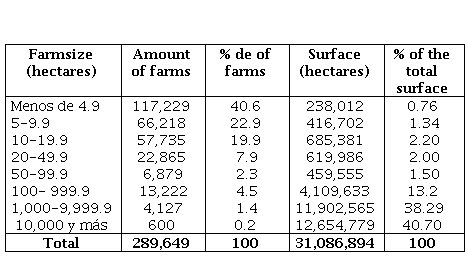
MAG (2009).
Next stratum of holdings reached 66,218 farms with an average area that does not reach 7 hectares and also operates under very precarious conditions in terms of the basic means of production which is land. The minifundization process in recent years has further reduced the size of these plots, which represent 63.5% of the total rural productive units between the two strata of smallholdings.
The rural population, which holds 20 hectares and less, represents more than 80% of the so-called Agricultura Familiar Campesina, AFC, (Peasant Family Farming) and despite the internal differentiation share common traits. Although that sector until the early 80s of last century contributed substantially to the total exports it is now mostly confined to marginal soils in pulverized plots, having decreased the area cultivated by these producers from 685,056 hectares in 2002 to 339,525 hectares in 2014 (Palau et al., 2016), equivalent to a loss of more than 50% in ten years. Certainly the peasant actor settled on viable soils is in danger of extinction.In a fulminant process, the Agribusiness advances by expelling peasants and indigenous people and communities.
Even when that small agriculture contributes to community cohesion, reproduces environmental resources and promotes organic farming and a healthy food system, it is disqualified as archaic and as an obstacle to development in the biased view of the agribusiness actors and considered not viable by public policies, which provides little technical assistance and focuses more on crops than on productive units or on the producer.
The peasantry is reconfiguring itself; this stratum of subsistence farming that would have been employed by other peasant units remained, as it will be seen, with that option substantially diminished and the retraction experienced by the sector as a result of the expansion of soybean agribusiness. In this scenario, the State identifies the peasant actor as object of welfare policies that are disappearing.
The aforementioned distribution results from the concentration process which is intensified since the mid-1990s, as it can be seen by examining changes in the inter-census period 1991-2008. On the one hand, the remarkable expansion of the agricultural frontier is showed, and on the other hand, the decrease of farms smaller than 200 hectares in quantity and area as observed in Table 3.
Thus, between 1991 and 2008, the total number of agricultural holdings decreased by 6%; the stratum of farms smaller than 200 hectares which includes the peasant productive units decreased in quantity and in the occupied area (15.6%). At the other end, farms larger than 500 hectares increased in quantity and in occupied area (Table 3). The area occupied by farms larger than 100,000 hectares totaling 600 increased by 30% in the inter census period.
Variation in the inter census period in number of farms and in the occupied area
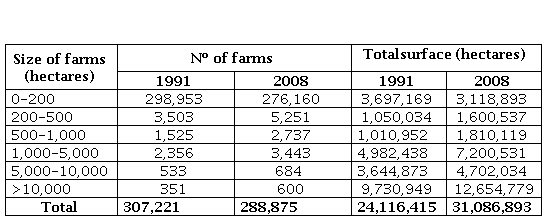
MAG (2009). Censo Agropecuario (2008).
Among owners with farms ranging from more than 31,000 hectares to more than half a million hectares, the largest area corresponds to foreign capital, including the Moon sect (590,000 hectares), the Espíritu Santo group (136,559 hectares), Favero group (129,817 hectares). The group also includes the most influential media owners and ex-president Cartes' group of companies, which provides further evidence of the connection between land monopoly and political power in Paraguay (Oxfam, 2017). It is important to note that the land owners are linked to commercial capital and financial capital, in addition to their activities in agribusiness as cattle ranchers or soy producers and in some cases as rentiers.
One aspect of the process of land concentration, accentuated with soybean production, is its hoarding by Brazilian producers. In other words, the foreignization of land occurs through individuals rather than large corporations or foreign states, as is the case in Africa (Borras et al., 2012; Blanc, 2015;Galeano, 2012).This land grabbing by Brazilians was already of such magnitude in 2008 that in the department of Alto Paraná 62.5% of farms larger than 1,000 hectares were foreign, and among these 55% Brazilian. In Canindeyú, another border department, the proportion of Brazilians among owners of more than 1,000 hectares already reached 60% by then.In recent years the hoarding in question has sharply increased and Brazilian nationality is more prominent among entrepreneurs of the agribusiness, what defines a peculiarity of the social structure that has as one of the dominant actors Brazilians with a prejudiced vision that disqualifies and discriminates against Paraguayan peasants. This fact has several consequences.
It is pertinent to note that in the case of Paraguayan social formation the development of agrarian capitalism separates direct producer from the land but does not generate a process of proletarianization; comparing data from the 1991 and 2008 censuses, a substantial decrease in temporary salaried work was observed, reaching 74.8%, while permanent salaried work remained unchanged. It can be stated that Lenin's Thesis is not met, which affirms that the development of agrarian capitalism results in a social structure with antagonistic classes defined by shared positions in the relations of production.
The big companies, which certainly is not constituted by rich peasants, with their cutting-edge technology displace peasants without generating employment, and temporary proletarianization is basically generated by the peasant units themselves that hire labor to complete their needs and only in a few cases become rich peasants and then entrepreneurs. Under these conditions the formation of a peasant salaried class that is based on the division of labor and with the same material interests are not given, although the resulting group shares a common consciousness that has more to do with its condition of being stripped; those already uprooted become dependent on multiple survival strategies including precarious jobs in urban belts and receiving remittances.
The mentioned process of uprooting and minifunding increases the differentiation of peasant productive units and weakens the peasant actor. Hence, the divisions between organizations,pointed out by some authors (Fogel, 2017), are much less due to intrigues among leaders than to the increasing heterogeneity of material interests, as well as regional differences. Also the class struggle, which in the Paraguayan case with an agro-export economy is rural andlinked to the land, is weakened; class conflict is limiting to local spaces.
The new actors that reconfigure the social structure include globalized actors such as the large agro-food regime corporations that operate on a global scale, the agro-business entrepreneurs and rentiers. Paying attention to the forms of land tenure presented in Table 4, calls attention the frequency of farms held as rented and concomitantly that of tenant rentiers. Paying attention to the forms of land tenure presented in Table 4, calls attention the frequency of farms held as rented and concomitantly that of tenant rentiers; in this sense it is pertinent to note that farms under 20 hectares that appear as soy productions in the 2008 Agricultural Census and represent 66% of the total number of farms that appear as soy producers in that source, are in fact tenant farms; soybean as a scale crop is not feasible in small farms. In the new context, the peasants who access plots with soils desired by the agribusiness with the lease of their land obtain incomes that would hardly be achieved with their own production.
Tenure forms according to farm size. 2008
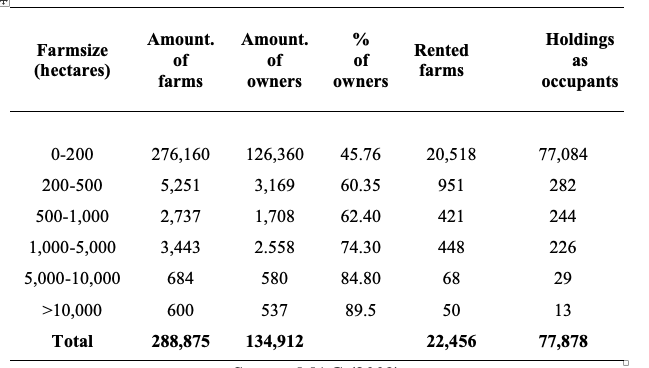
MAG (2009).
Of the 22,456 landowners who receive income from renting their land, 17,691 are small producers who hold plots under 20 hectares and lease small areas. At the other end 586 owners are rentiers with plots greater than 1,000 hectares they are leased mainly for soy production, and they receive at least half a million dollars a year for renting their land.
At leasta part of them holds lands that are public goods, which are emblematic cases of accumulation by dispossession. It is remarkable that 268 large producers with farms greater than 1.000 hectares were registered in the 2008 Census as mere occupants; it can be assumed that these are public lands, and that those who possess them are usurping public goods.
The most important actors in the agribusiness arrived in the country with the new globalized diet including representatives of large transnational corporations that exploit biotechnology, which are the most important economic actors in the neoliberal diet. The following table shows the main transnational corporations operating in the country, and as a dominant actor on a global scale they control development, production, processing, export and/or distribution of biotechnological products, especially soybeans, soybean oil and beef, for its clients, the medium and large businessmen of the agribusiness to whom it subordinates.
On a global scale, some of these corporations control the production of inputs while others monopolize the export of agribusiness products; even those that make up a third group also control the processing. Only five corporations Syngenta, Dow, Basf, DuPont and Bayer-Monsanto control 75% of the market; after the merger Bayer-Monsanto, which began in 2016, the resulting transnational company will control 25% of the world pesticide market and 30% of the seed market. The economic power of these big corporations and the media support, added to their dishonest practices, explain to an important extent the adherence to their ideas by local professionals who extol benefits of the system.
Five of the 18 largest agribusiness corporations engaged in import and export process and export beef, and among them the Brazilian capital control most of the processing and export, although some of them also involved in production itself or in any case acquire livestock from Brazilian producers; one of them was the JBS, the largest meat company in the world started in 2016 with an export of 226 million dollars[3]. The JBS, with capacity to slaughter 1,200 heads per day, illustrates well the corrupt practices of large corporations to be involved in bribes to Brazilian ex-president and the scandal that rocked Brazilian political world; this bribery scandal determined the transfer of its assets.
It is noteworthy that in the case of beef the participation of Brazilian companies is given at all stages of the chain, covering much of the production, processing, export and distribution. In the case of JBS, it was one of the largest meat companies in the world that had multi-million dollar subsidies from the Brazilian government through the National Bank for Economic and Social Development (BNDES).
The continued expansion of Brazilian economy in Paraguay is given basically through the land grabbing, the progressive control of soybean agribusiness and livestock production, the processing and export of beef, and the maquila. This expansion of the Brazilian economy is actively promoted by the Brazilian government through subsidies, diplomacy and legislative measures, although in the case of soybean entrepreneurs, they are fully subordinated to large corporations basically of US capital. The subsidies which financed the expansion of Brazilian monopolies in Paraguay occurred through the BNDES (Vuyk, 2013).
Major agribusiness corporations and their operations. 2018
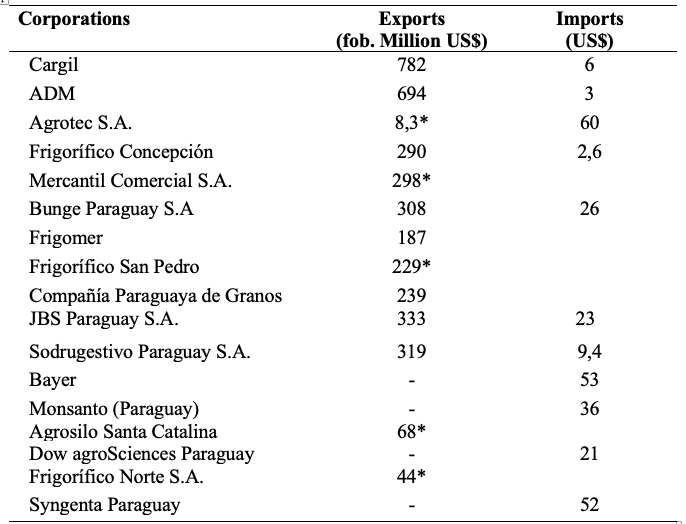
Informe Estadístico. Dirección Nacional de Aduanas (2018).Note: * 2017 data.
The commitment from the State to the neo-extractivism promoted by the large biotechnological corporations is expressed openly and systematically and manifests itself in various ways; the intensity of support to agribusiness increases with the direct control of the State by representatives of the powers. Policies in both actions and omissions point to exclusive territorial projects that aim to remove peasants and indigenous people from arable land; to such an extent, that intervention of thugs or private guards in the evictions is promoted, sometimes acting jointly with the National Police. In fact, judges and prosecutors have as one of their functions to give veneer of legality to a process of accumulation by dispossession often of public resources, confirming the validity of the statement of Thrasymachus of Chalcedon who defined justice in antiquity as what suits the stronger (Alvarez, 2018)[4].
While the parliament understands that should not collet tax on the agribusiness and dictates laws that facilitate its expansion, the government is reducing the budget of the Ministry of Agriculture and Livestock to such an extent that in relation to what was allocated was reduced by almost half in 2014, and resources are increasingly applied to larger farms[5]. In turn, the IPTA devotes its resources increasingly to research and experimentation on GMOs in association with large corporations; paradoxically this is the commitment to achieve national development.
In addition to reconfiguration of the agrarian structure, the neo-extractivism has a remarkable socio-environmental impact; In fact, the expansion of the agro business in question faced by intensive companies of capital that produce in monoculture regime in scale implies an intense deterioration of the natural resources which constitute the natural capital of the country. Even when the area cultivated by GM crops, led by soybeans, has significantly extended, the increase in the amount of poisons used was much higher; that is to say, every time it is used more agro-toxic and with more toxicity by area cultivated withtransgenic, such the case of herbicides due to resistant weeds that now reach 12, and that require the use of desiccants more harmful for human and environmental health.
One of the herbicides in question is known as 2-4D Agent Orange used as a chemical weapon in Vietnam War. Only between 2014 and 2015 imports of 2-4D increased by 9.4% while that of Paraquat increased by 62.4%.The progressive increase of poisons is of such magnitude that only in the first months of 2015, entered the country 31 million kilos and 20 million liters, which were applied to soils, polluting the environment; in order to measure the magnitude of the problem, it must be considered the fact that Paraguay is the country with the largest portion of GM crops and it can be assumed that theburden of 9 kilos of biocides per inhabitant is the highest, at least in the region (Palau et al., 2016).
Regarding the increase of resistant weeds in Paraguay, in an endless process, Monsanto has patent applications of herbicides resistant to these plants (Fogel, 2017).The increasing use of herbicides and with increasing toxicity is part of the development of the agribusiness productive forces that not only alters the relations of production, by separating peasants from their means of production without proletarianizing them, but also by showing the limits of GMO technology, which causes severe damage to human and environmental health, and by their rising costs and rejection generated in markets it is self-destructing.
Also the increasing use of chemical fertilizers shows diminishing returns that progressively require applications of greater magnitude so the increase of volume imported increased by 31% between the years 2014 and 2015 (SENAVE, 2014; SENAVE, 2015). Based on the impacts on human health as early as the 90s of the last century, investigations of research centers of excellence in the northern hemisphere has proved the highly harmful effects on human health of the herbicide 2-4D used in the Vietnam War, particularly its carcinogenic effect, the damage to the nervous system, and deformations in descendants of the population exposed to its use (Fogel, 2001). In recent years, new research has focused on the growing neurological damage caused by agrochemicals and particularly on the effects of glyphosate on prenatal health(Bellinger et al, 2016; Falnoga et al., 2000; Mesnage et al., 2013; Mesnage et al., 2014; Nevison, 2014; Seneff et al., 2015; Seralini et al., 2014;Swanson et al., 2014).
Thus, Seneff et al. (2015) present evidence of the synergistic incidence of glyphosate and aluminum in pathologies of the pineal gland, related to intestinal dysfunctions and neurological diseases. Various neurological disorders including autism, depression, dementia, anxiety disorders, Parkinson's disease are associated with abnormal sleep patterns directly linked to dysfunctions of the pineal gland; various neurological disorders including autism, depression, dementia, anxiety disorders, Parkinson's disease are associated with abnormal sleep patterns directly related to dysfunctions of the pineal gland; in turn, this gland is highly susceptible to two substances with a strong presence in the industrialized nations which are aluminum and glyphosate; the latter is an active ingredient in the Round Up herbicide.
The authors show that toxic substances referred to synergistically affect the production of neurological damage; glyphosate interferes with intestinal functioning by affecting the metabolism of chemicals necessary for the brain. Its p-resol toxic product is linked to autism in humans and in rats used in trials; this substance intensifies the absorption of aluminum; likewise it is pointed out evidence of synergistic interaction between aluminum and glyphosate leading to imbalances in the functions of the pineal gland. The aluminum chelate of glyphosate allows the ingestion of aluminum surpassing the intestinal barrier, which leads to hypoxia-inducing anemia, promoting neurotoxicity.
The study presents solid evidence that links the remarkable increase of autism in the United States, as well as other neurological diseases mentioned with chemicals in the environment; glyphosate application data were obtained from the US Department of Agriculture, which allows determining the relationship between the area of certain spaces exposed to the use of glyphosate and the incidence of neurological diseases referred to. The correlation is demonstrated in statistical and theoretical terms biomedical sciences.
In turn Bellinger et al. (2016) analyze the effects of exposure to neuro toxics in early life including the prenatal stage, incorporating the context of children's development into neurodegenerationresearch.Ailments caused by exposure to neuro toxics in early life hinder cognitive development and are in the early development of cascades of events that can cause additional pathologies that differ from those initially observed.
The aforementioned exhibition has an intrafamilial and intergenerational impact and influences the child's ability to respond to future negative actions. This is an environmental factor that alters biological processes and affects subsequent development; the neurological damage suffered in early childhood is in a cliff that includes anxiety, anemia, dementia, schizophrenia and behavioral manifestations crisis.
The authors are based on solid evidence showing that deficits associated with exposure to neurotoxins are usually immutable; they affect the microstructure of brain development. The cumulative risks associated with the mixtures have been evaluated, focusing the analysis on chemicals with a similar structure or modes of common action. Since 1996, the cumulative effects of multiple chemicals with common toxicity mechanisms have been considered.
Neuropsychological deficits include poor processing of verbal or visual information, inability to maintain attention, disorganization of problem-solving strategies, difficulties in communication processes and even antisocial behaviors; these ailments involve damage to the nervous system that are not openly expressed. Chemical aggressions to the brain cause various diseases, one case studied is the relationship between prenatal exposure to lead and schizophrenia, and it is the poor children who suffer the most deficits associated with lead's neuro toxicity, which are permanent, since they are more exposed to poison sources and their homes are more precarious (Padilla et al., 2014).
Likewise, in a recent study, the contamination with toxic substances of dairy cows fed with concentrates of soy, corn and other grains was investigated in Denmark and it was determined that all of them excreted glyphosate in their urine and the effect of this active principle was demonstrated in the muscle cells and in the liver of these animals; from the impact of agrochemical in question in blood parameters is inferred its genotoxic and teratogenic activity (Krüger et al., 2013).
In Paraguay, the morbidity associated with environmental pollution is high and it can be assumed that it is escalating; congenital malformations as a cause of infant mortality reached 2.86 per thousand live births in 2008 and 4.40 per thousand births in 2015 and are the first in importance (MSP and BS, 2017). In turn considering mortality indicators by large groups of causes tumors are the second leading cause and increased from 58.9 / 100,000 in 2014 to 65.9 / 100,000 in 2015 (MSP and BS, 2017). Moreover, the Ministry of Public Health in the resolution approving the national health policy refers to malignant neoplasms as the second leading cause of death[6].
Even when the social determinants of health are mentioned in the conceptual framework and refer to the development of actions that address these determinants, strengthening the surveillance of occupational factors and environmental factors that may affect health and despite the overwhelming evidence of severe health damage caused by pesticides that reachthe population through contaminated food, the Ministry of Health paradoxically promotes the consumption of soy in needy families[7].
Thus, the Director of Social Welfare Institute of the Ministry of Public Health recently reported that due to the success of CAPECO's "Nutrition with Soy" program, the government is interested in replicating that experience in 72 family centers of the Ministry of Public Health.
Diverse are the derivations of the expansion of agribusiness and particularly of the development of its productive forces which impose limits to its own reproduction, as they deplete fertility of the soil and generate resistant weeds, and the chemical contamination of their own production will begin to generate rejection of the most demanding markets. From the evidence presented derives the self-destructive nature of the technology used by neoextractivism. The strong impact on public health is added to the destruction of natural capital.
Environmental pollution, which is more intense than in other countries, manifests itself in multiple diseases, among them the neurological ones, associated with the increase in the use of glyphosate and other pesticides; the derivations of these damages developed in cascade raises the need to pay attention to the relationship between growing antisocial behaviors and neuro degeneration.
This circumstance raises the urgent need for public health policies that would address environmental pollution; referring these policies to child protection should pay attention to deficits associated with early exposure to neurotoxic which cause immutable pathologies. In these cases, the alternative available is to face the environmental factors that are causing irreversible damage; prevention of exposure to pesticides is a goal that should not be discussed.
The social Darwinism characteristic of neoextractivism implies the increasing accumulation of a small sector and the annihilation of entire collectivities of peasants and indigenous people.
Bearing in mind that the expansion of agribusiness will continue to feed the land hunger at a global level and that the basic function of the Paraguayan State is to defend the interests of its citizens, public policies should seriously consider protecting this resource.

Figure 1
Cultivated soya area and yields
CAPECO (2018).

Figure 2
Soybean and soybean oil price indexes in the International Market, 2001-2014.(Index 2000 = 100)
United Nations. Statistical Annex (2014).
Annual growth (in %) of soybean area and pesticides import

SENAVE (2018b).
Distribution of farms according to size. 2008

MAG (2009).
Variation in the inter census period in number of farms and in the occupied area

MAG (2009). Censo Agropecuario (2008).
Tenure forms according to farm size. 2008

MAG (2009).
Major agribusiness corporations and their operations. 2018

Informe Estadístico. Dirección Nacional de Aduanas (2018).Note: * 2017 data.


